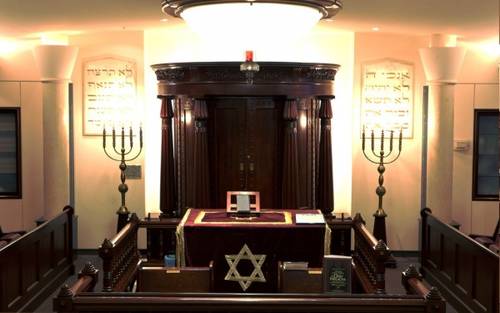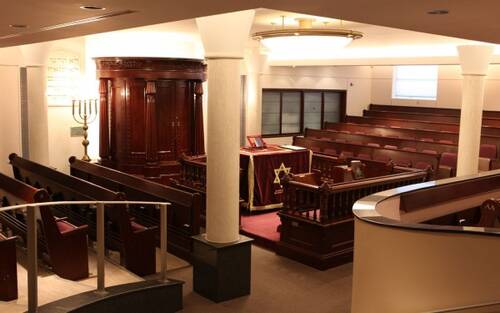PARACHAT VAYAKHEL, 2 MARS 2019/ 25 ADAR 1 5779
Petihat Hahékhal : Marc Arazi/ Chabbat prochain : Joe Sasson
Parachat Vayakhel est souvent jumelée à la paracha suivante de Pékoudé
Cette année, ayant 2 Adar, elle est lue séparément . Ce Chabbat c’est Chabbat Mévarkhim le nouveau mois de Adar Chéni, Et aussi c’est Chabbat Chékalim. Nous sortons 2 Séfarim, le premier pour Vayakhel, et le second pour Haftarat Chékalim ,Ci-dessous dans ce bulletin, on explique la signification de Mévarkhim et Chékalim
En honneur de Chabbat Mévarkhim, Muriel et Mayer Sasson offrent le kiddouch-Luncheon dans la salle Aintabi. Hazzakim Ouvroukhim
POURIM 5779
Le mercredi 20 Mars, nous célébrons la fête de Pourim
Cadeaux aux enfants déguisés, MAGICIEN , Succulent buffet pour les enfants et les adultes, Hamentashen, Desserts etc…etc…
Venez nombreux!!!!!
LA PARACHA EN BREF
Moïse rassemble le peuple et renouvelle le commandement d’observer le Chabbat : « durant six jours le travail sera fait et le septième jour sera saint pour vous, un repos complet pour l’Eternel ». Il transmet alors les instructions divines concernant l’édification du Tabernacle.
Le peuple donne en abondance les matériaux nécessaires. Moïse doit faire proclamer dans le camp qu’on cesse d’apporter des dons.
Une équipe d’artisans au cœur inspiré construit le Tabernacle et fabrique ses ustensiles (comme déjà détaillé dans les précédentes sections hebdomadaires, Térouma, Tetsavé et Ki Tissa) : les tentures attachées par des agrafes d’or, des poutres en bois de chittim recouvertes d’or et leurs socles d’argent, le Parokhet (le Rideau) séparant les deux chambres du Sanctuaire, le Massakh (le voile) à l’entrée de la Tente ; et l’Arche avec les chérubins, la Table recouverte d’or et sa bordure en or, le Chandelier à sept branches et son huile, l’Autel des encens, l’Huile d’Onction et l’Autel des sacrifices, la cuve et son piédestal faite avec les miroirs de cuivre apportés par les femmes.(Chabad.org)
shabbat Mevarchim
 By: Rabbi Ari Enkin
By: Rabbi Ari Enkin
There is an ancient custom to bless the upcoming Jewish month on the Shabbat which precedes Rosh Chodesh. These Shabbatot when the new month is blessed are referred to as “Shabbat Mevarchimâ€. A central feature of this prayer is the public announcement of the exact time the new moon, known as the “moladâ€, is set to appear.[1] The molad is the exact moment of the moon’s renewal. Recall that at the concluding moments of every lunar cycle the moon is positioned directly between the earth and the sun and is completely invisible. A few hours following this occurrence the moon is once again visible, albeit only the most minute portion of it. At such time the “molad” the “birth” is recognized as having taken place and a new Jewish month has begun.
The prayer for the new month is conducted in a somewhat distinguished manner. It is led by the Chazzan while holding the Torah. The prayer announces the name of the upcoming month along with the exact moment the new moon is set to appear. It also serves to alerts the congregation as to which day(s) of the coming week will be observed as Rosh Chodesh. Finally, it asks that God renew the upcoming month with all forms of blessing. It is often carried out in an elaborate and impressive manner.
It is actually quite important that the exact time of the molad be announced.[2] Doing so allows people to determine when the latest opportunity is for them to recite the Kiddush Levana. It also represents our efforts to familiarize ourselves with the workings of the calendar. Indeed, we are strongly encouraged to somehow participate in the calculating of celestial matters.[3] Yes, learning the basics of astrology is a mitzva! [4]
Announcing the molad also recalls the ancient practice of “Kiddush Hachodeshâ€. In Temple times the new month was declared by the Beit Din based on manual calculations along with the testimony of witnesses who would have claimed to have seen the moon’s renewal. It is rather essential to be standing when reciting this prayer as the ancient Kiddush Hachodesh was only acceptable if performed while standing.[5] Although it is technically to recite the “Mevarchim” prayer on any day of the week preceding Rosh Chodesh, universal custom is to recite it on Shabbat when more people are to be found in the synagogue.[6] Indeed, it is always commendable to make an effort to perform mitzvot in the presence of as many people as possible.[7]
.
CHABBAT CHÉKALIM
Le Chabbat Chékalim est le Chabbat précédant Roch 'Hodech Adar (ou Chabbat Roch 'Hodech Adar). Lors d'une année bissextile ce Chabbat tombe en Adar 2.
2. Ce Chabbat, on sort deux rouleaux de la Torah. Dans le premier rouleau, nous lisons la section hebdomadaire et dans le deuxième, nous lisons Parachat Chekalim (Chemot 30: 11-16). Si ce Chabbat est également le jour de Roch 'Hodech, on sort également un autre Séfer Torah dans lequel on lira le passage relatif à Roch Hodech (On lira en premier la Paracha de la semaine, puis la paracha liée à Roch 'Hodech et enfin la Parachat Chékalim).
3. La parachat Chekalim traite de l'obligation de chaque membre du peuple d'Israël d'amener le demi-shekel pour les sacrifices publics amenés au Temple. Au temps du Beit Hamikdach, chaque Juif avait l'obligation de faire don d'un demi-shekel chaque année pour acheter les sacrifices publics destinés au Temple.
4. Les quatre parachiot suivantes à savoir, Chékalim, Zakhor, Para et le Ha'Hodech sont particulièrement sacrées et sont lues respectivement sur quatre Chabbat. 5. Le Chabbat Chékalim est une Ségoula pour la Parnassa (Ateret Yechoua). De même, lors du Chabbat Chékalim on a la possibilité de demander à ce que toutes nos prières soient agrées (Imrei Yosef).
6. 7. Le Chékalim qui étaient donnés par le peuple devaient atteindre le Temple jusqu'à Roch 'Hoodech Nissan. C'est alors qu'ils achetaient des sacrifices avec ce nouveau don, et la nation entière d’Israël devait en bénéficier : c'était une expiation pour tout le peuple. Sur l'ordonnance du demi-shekel il est stipulé que "les riches ne doivent pas donner plus et que le pauvre ne doit pas donner moins qu'un demi-shekel" (ibid., Verset 15). Afin que le riche se sente pas supérieur au pauvre et que tout le monde soit égal. Et pour que les pauvres sachent que les sacrifices seront apportés avec la même ferveur et au même titre que ceux des riches. Le fait que les sacrifices aient été achetés avec l'argent de tout le peuple prouve l'unité de celui-ci.
Vayakhel Quiz
1) Q. Why is the prohibition against doing work on Shabbat written prior to the instruction for building the Mishkan?
A. The rabbis use this juxtaposition to teach that the building of the Mishkan doesn't supersede the laws of Shabbat. We also learn that since building the Mishkan is forbidden on Shabbat, it must be that all activities that were required to build the Mishkan are forbidden on Shabbat. This is where we learn the 39 forbidden activities on Shabbat (cooking, sewing, building, etc.)
2) Q. Why does the Torah write so much about all the details that went into building the Mishkan?
A. We are taught that when the Torah wants to emphasize a good deed it spends a lot of time describing that subject, and repeats it. In Bereshit (24:42) the story of Abrham’s servant meeting Rivka is repeated twice. This is to stress the servant’s dedication and loyalty to Abraham in trying to find a wife for Yitzhak (other’s believe that it is because there were 2 different traditions regarding the story that got meshed together but this is not the traditional explanation). Similarly, here Hashem wants to stress his love and appreciation to Bnei Yisrael who devoted themselves both physically and financially to the building of the Mishkan. Another explanation (taught to me by my father) may be that Hashem wanted to specify very clearly what is allowed to be done in the Mishkan, so that all other additions would be forbidden.
3) Q. What was unusual about the way the women spun the goat's hair?
A. The midrash teaches that it was spun directly from off of the backs of the goats.
4) Q. Why were the Nesi'im (Princes) the last ones to contribute to the building of the Mishkan?
A. The Nesi'im reasoned that they would first let the people contribute materials needed for the Mishkan and then they would contribute whatever else was lacking. The Torah shows its dissatisfaction by deleting a letter from their title. This Midrash is teaching us that although they may have had good intentions, everyone should donate whatever they can immediately and not wait for everyone else to donate first.
5) Q. The Torah specifies here that it is forbidden to kindle fire on Shabbat. Why does it single out fire out of all the other actions that are forbidden on Shabbat?
A. One possible explnation is that on Yom Tob the Torah says that one may transfer fire for food. The Torah did not want any one to make an error and think that this law also applies to Shabbat, so the Torah stresses, "Do not kindle fire on Shabbat."
6) Q. Who does the Torah identify as the primary builders of the Mishkan and which tribes were they from?
A. Betzalel Ben Uri from the tribe of Yehuda and Aholiab Ben Achisamach from the tribe of Dan. They are treated equally even though Betzalel is from the most prestigious tribe and Aholiab from one of the least prestigious. The Tanach and the rabbis have always stressed that what makes someone important is what he or she does, not which family they come from. This lesson is taught in the Tanach many times, yet today many people still have failed to grasp the message of our religious leaders. Too often today we still see communities cater to those from more prestigious famillies rather then to those who contribute the most, not just from a financial standpoint from from a social and religious standpoint.
Deux mois d'Adar
Une double dose de joie

Une fois tous les deux ou trois ans, le mois d’Adar double de taille. Ceci est dû à la structure particulière du calendrier juif : l’année juive étant composée de 12 mois lunaires, elle ne compte que 354 jours (12x29.5). Pour la garder en phase avec les saisons de l’année solaire de 365,25 jours, une année de 13 mois dite « embolismique » est insérée à sept reprises dans chaque cycle de 19 ans. Le mois supplémentaire est Adar II, ce qui nous donne 60 jours d’Adar, 60 jours de joie.
« Soixante » est un nombre qui figure en bonne place dans les lois alimentaires de la Torah (les lois de l’alimentation cachère). Si une substance non-cachère est dissoute ou cuite avec de la nourriture cachère, l’ensemble est rendu impropre à la consommation. Toutefois, si l’« influence négative » est égale ou inférieure à un 60ème de la masse totale, elle est « annulée dans soixante ». Et non seulement la « substance impure » est-elle neutralisée, mais elle devient même partie intégrante de l’ensemble.
De tous les mois, Adar est le seul qui puisse passer de trente à soixante jours. Car Adar est le mois de la transformation joyeuse, le mois qui possède le « pouvoir d’annulation dans soixante ». Le pouvoir de transformer une force indésirable, et même destructrice, en une joie nourrissante.
PROVERBES
Si la barbe était signe de sagesse, la chèvre serait Socrate
Agir sans penser, c'est tirer sans viser
Le mariage a ses peines, mais le célibat n'offre que peu de plaisirs
L'ignorance de la loi n'est pas une excuse
Un frère peut ne pas être un ami, mais un ami peut être un frère pour toujours
Prends soin de ton caractère, et ta réputation prendra soin d'elle-même.
N'allonge pas ton bras au delà de ta manche
Un bon chirurgien doit avoir l'œil d'un aigle, la main d'une femme et le cœur d'un lion
Si les vieilles marmites pouvaient parler, on connaîtrait bien des secrets
Mieux vaut une bonne renommée que du bien plein la maison
Une jeunesse sans amour est un printemps sans fleurs
Femme avisée épouse qui l'aime plutôt que qui elle aime.
SHABBAT SMILE
Rabbi Schwartz answers his phone.
"Hello. this Rabbi Schwartz?"
"It is."
"This is the IRS. Can you help us?"
"I can."
"Do you know a Sam Cohen?"
"I do."
"Is he a member of your congregation?"
"He is."
"Did he donate $10,000?"
"He will
A pious man who had reached the age of 105 suddenly stopped going to synagogue. Alarmed by the old fellow's absence after so many years of faithful attendance the Rabbi went to see him.
He found him in excellent health, so the Rabbi asked, "How come after all these years we don't see you at services anymore?"
The old man looked around and lowered his voice. I'll tell you, Rabbi," he whispered. "When I got to be 90 I expected G-d to take me any day. But then I got to be 95, then 100, then 105. So I figured that G-d is very busy and must have forgotten about me .....and I don't want to remind Him!"
A man approached old Mr Katz in a town he was visiting. "What's the quickest way to New York?"
Mr Katz scratched his head.
"Are you walking or driving?" he asked the stranger.
"I'm driving."
"That's the quickest way!"
Excuse me," Nissbaum said to the cashier at David's Deli, as he examined the check, "what's this eight bucks for?"
"For the chopped liver sandwich, sir."
"Really?" said the startled customer. "Whose liver was it, Rockefeller's?"
CHABBAT CHALOM
MAGHEN ABRAHAM
David Hasson








 By: Rabbi Ari Enkin
By: Rabbi Ari Enkin